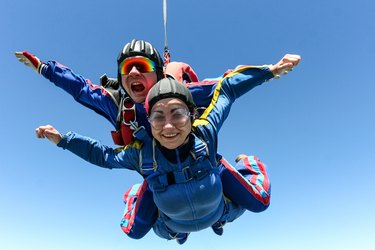
During an adrenaline rush, you feel almost superhuman. Also known as the fight-or-flight response, an adrenalin rush represents a coordinated whole-body response to a perceived threat that prepares you for strenous physical activity virtually instaneously. This response involves your brain, nervous system and adrenal glands.
Brain Initiation
Video of the Day
A primitive part of your brain called the amygdala continuously monitors input from your senses and sounds the alarm when it perceives a potential threat. Your amygdala relays the message to the nearby hypothalamus, which triggers activation of your sympathetic nervous system, a branch of your involuntary nervous system.
Video of the Day
Initiation of the fight-or-flight response occurs automatically in a split second before you have a chance to think about what's happening. Therefore, an adrenaline rush sometimes occurs in response to a false alarm, such as when you're startled by something harmless like a car backfiring.
Sympathetic Nervous System Activation
Your involuntary nervous system regulates automatic body functions, such as digestion, maintaining your blood pressure and the beating of your heart. The sympathetic and parasympathetic branches of your involuntary nervous system have opposite effects on your body.
The parasympathetic nervous system is the rest-and-digest branch while the sympathetic is the fight-or-flight branch. Both branches are continuously active but one predominates over the other at any given moment, depending on your activity level and other factors.
During a fight-or-flight response, your hypothalamus slams the brakes on parasympathetic activity and opens the throttle on sympathetic activity. This results in rapid-fire signals that travel via sympathetic nerve cells that originate in your brainstem and spinal cord.
After exiting your spine, most of these nerves communicate with additional sympathetic nerve cells that travel to your body organs and tissues where they release the neurotransmitter norepinephrine, also known as noradrenaline. This chemical messenger binds to receptors on body organs and tissues and iniates the immediate effects during a fight-or-flight reaction.
Adrenal Gland Stimulation
Some sympathetic nerves that originate from your brainstem and spinal cord travel to your adrenal glands after exiting your spine. More specifically, they communicate with the interior of these glands known as the adrenal medulla, which produces adrenaline and norepinephrine. Adrenaline predominates, accounting for roughly 80 percent of the hormones produced by the adrenal medulla.
High-level sympathetic nerve stimulation during a fight-or-flight reaction causes the adrenal medulla to release a large bolus of adrenaline and norepinephrine into your bloodstream. Your blood carries the hormones to your body organs and tissues where they bind to receptors and perpetuate the fight-or-flight response.
This is necessary because while direct sympathetic nerve stimulation and the related physical effects occur almost instantaneously, they are rather short lived. There is roughly a 20 to 30 second delay for the physical effects to kick in from the rise in blood levels of adrenaline and norepinephrine but they last approximately 10 times longer than direct sympathetic nerve stimulation.
Effects in Body Organs and Tissues
The rush of adrenaline and norepinephrine as well as direct sympathetic nerve stimulation lead to numerous, simultaneous effects in your body that prepare you for fight-or-flight. Blood flow to your skin, digestive system and kidneys decreases, which allows increased blood delivery to your muscles.
Your heart beats faster and more forcefully so more blood is pumped to your body each minute. Your breathing rate increases and the airways dilate allowing you to take in oxygen more quickly. Additional physical effects include:
- Increased blood pressure
- Increased blood flow to the brain
- Increased blood sugar and fatty acids to fuel the muscles
- Increased sweating
- Increased ability to maximize muscle power
- Decreased stomach and intestinal activity
- Decreased sensitivity to pain
- Goose bumps
- Hair-standing-on-end sensation
- Dilated pupils
Termination and Other Considerations
The fight-or-flight response enables your body to immediately respond to a threatening situation with a short-term burst of strenuous physical activity. As soon as the threat passes or you realize there was no real danger, everything returns to baseline within a few minutes.
Your adrenaline level increases in situations other than a fight-or-flight reaction, such as when you're exercising. Medical conditions can also increase sympathetic nervous system activity and elevate your adrenaline level. Examples include a heart attack, heart failure and any condition leading to shock. Rare tumors can also cause high adrenaline levels. In general, however, there isn't the sensation of an adrenaline rush that occurs during a fight-or-flight reaction.
Reviewed and revised by: Tina M. St. John, M.D.
Is this an emergency? If you are experiencing serious medical symptoms, please see the National Library of Medicine’s list of signs you need emergency medical attention or call 911.